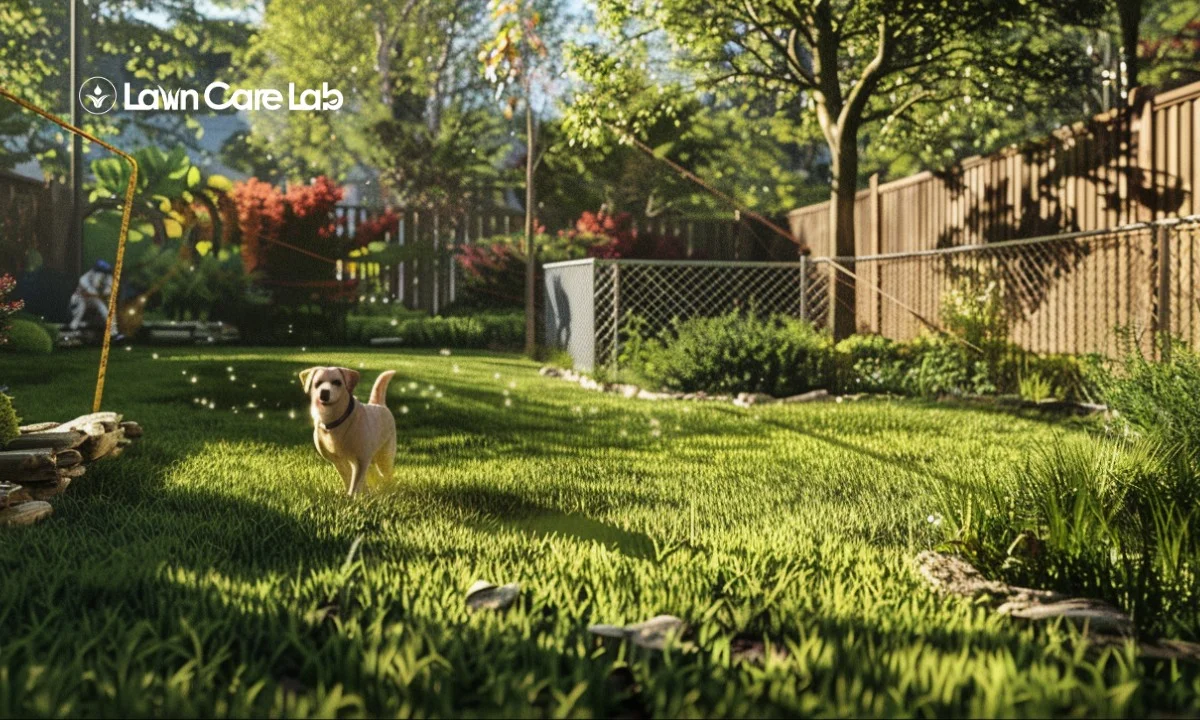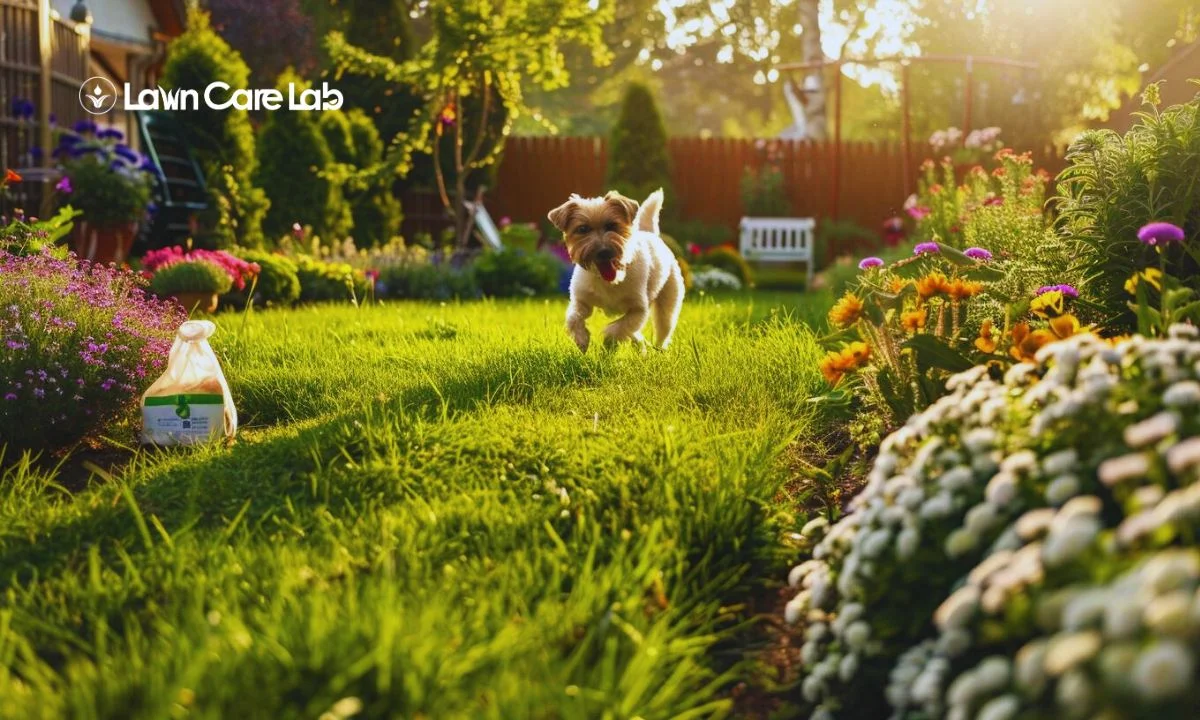Taking the initiative to involve your kids in gardening activities? Commendable! This comprehensive guide offers a roadmap to seamlessly blend practical advice, learning experiences, and safety precautions to transform gardening into an enjoyable family activity.
We’ll also share ways to rejoice in your family’s horticultural accomplishments. Let’s cultivate your children’s gardening skills by engaging kids in lawn care in a shared experience that fosters their intellectual growth, sense of responsibility, and self-respect.
Table of Contents
Lawn Care as a Family Endeavor
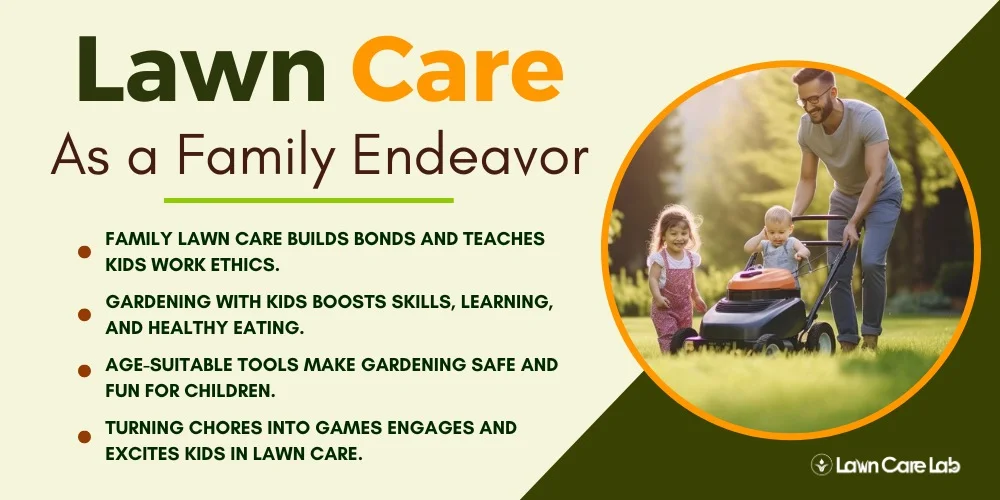
Engaging the whole family in maintaining your lawn can be an enriching experience. Lawn care as a family activity enhances your yard, strengthens family ties, and teaches children about responsibility and hard work.
Tending to your lawn together as a family encourages outdoor play, fosters a healthier environment, and inspires respect for nature.
The Benefits of Including Kids in Gardening Tasks
Gardening with kids offers plentiful advantages beyond completing the task at hand.
Kids enhance fine and gross motor skills through digging, planting, watering, and weeding.
Gardening is a living lab for biology, ecology, and chemistry lessons. It also offers practical applications of math through measuring and counting.
Children are more likely to try and enjoy fruits and vegetables they’ve helped grow, promoting a habit of healthy eating.
Regular gardening tasks help children learn planning and persistence, as caring for plants requires ongoing attention.
Kids develop an appreciation for the environment and an understanding of the natural world’s cycles and diversity.
A garden’s diverse textures, colors, and scents stimulate children’s sensory systems.
Shared responsibilities in the garden lead to bonding and teamwork.
Children grow their knowledge and understanding by gardening while nurturing their connection with family and the earth.
Tips for Making Lawn Care Appealing to Children
Engaging your children in lawn care tasks need not be a challenge. The trick lies in selecting gardening tools that are suited to their age and skill set. A dash of creativity can transform mundane chores into entertaining games, sparking their curiosity and making them eager participants.
In today’s fast-paced world, it’s increasingly vital to encourage children to connect with nature. Lawn care provides a perfect opportunity to achieve this. Selecting age-appropriate gardening tools ensures their safety while fostering a sense of responsibility.
Consider turning ordinary tasks into amusing games. For instance, a leaf-raking competition or a ‘find the weirdest weed’ contest. Not only will this bring an element of fun to the activities, but it will also make your children more enthusiastic about their involvement.
Selecting Age-Appropriate Gardening Tools for Kids
Involving your youngsters in the art of gardening begins with equipping them with the appropriate tools crafted for their age. Prioritize safety and kindle their budding interest by opting for lightweight, plastic tools for the younger ones.
As they grow – in strength and height – gradually transition them to more robust tools. This thoughtful progression ensures their safety and fuels their budding passion for this shared family activity.
Gamifying Gardening Tasks to Boost Enthusiasm
Imagine turning the regular upkeep of your garden into a fascinating activity for your kids. This approach instills a love for nature and makes routine tasks seem less drab. Here’s how you can do it:
- Set up a scoring scheme for each task – This adds an element of competition and allows children to track their progress.
- Celebrate the child who amasses the most points – Celebrations act as an incentive, motivating them to participate actively.
- Plan a ‘garden treasure hunt’ – This creative spin adds an element of surprise to daily chores.
- Secretly place items in the garden for kids to find as they work – Discovering hidden objects boosts their excitement and engagement.
Get your kids involved in gardening to help them learn responsibility, appreciate nature, and have fun. It doesn’t have to be daunting; follow these tips for an enjoyable gardening experience with your family.
Planning Your Family Gardening Day
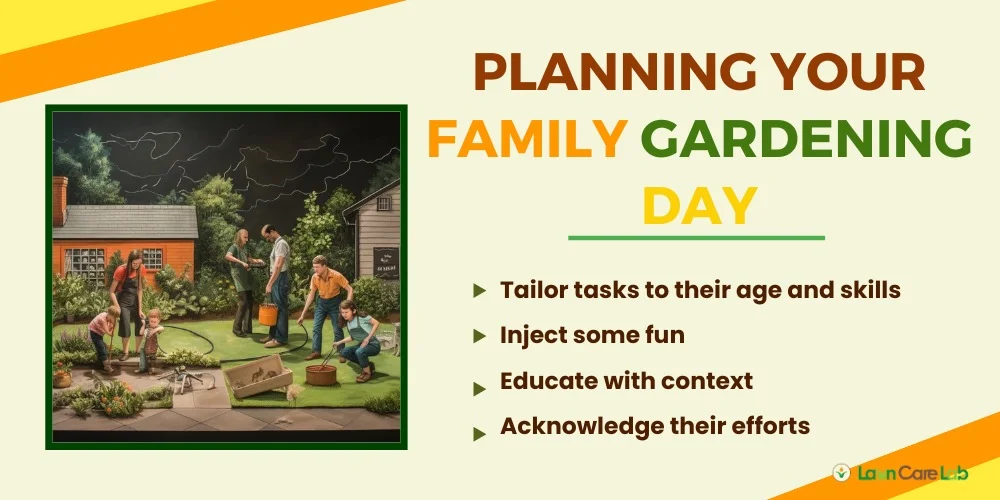
Planning a family gardening day can be fun and educational, offering a great way to bond while teaching kids about the environment.
Choose a good weather day, set achievable gardening goals for your children, and gather tools beforehand.
Create a flexible schedule with a mix of tasks and breaks to keep everyone engaged. Teach kids about nature by involving them in gardening, but prioritize safety by supervising them, especially when using tools.
Lastly, celebrate your achievements together, perhaps with a special treat or a picnic in your new garden space, reinforcing the sense of accomplishment and making the experience memorable.
Setting Realistic Gardening Goals with Children
Setting realistic expectations for your children to ensure they enjoy the experience without feeling overwhelmed is important.
Here’s some guidance on how to do this:
Tailor tasks to their age and skills: Allow young children to do straightforward tasks like watering plants. Older children, meanwhile, may enjoy more challenging responsibilities such as pruning or planting.
Inject some fun: Transform garden maintenance into an exciting challenge. Maybe it’s a race to see who can pull out weeds quickly or water the most plants.
Educate with context: Rather than simply assigning tasks, explain the significance of each one. This helps children understand their contribution to gardening and feel more invested.
Acknowledge their efforts: Show appreciation for their hard work through a small reward or words of praise.
Safety should always be a priority. Equip them with appropriate tools and supervise their activities to mitigate potential mishaps.
Creating a Kid-Friendly Lawn Care Schedule
Craft a child-friendly yard maintenance routine to transform gardening day into an engaging learning event. Utilize a graphic timetable like a diagram or blueprint to make it more inviting.
Break down chores into manageable tasks and include breaks for rest and snacks. Keep kids engaged by assigning them different chores.
This exercise teaches life lessons such as accountability, collaboration, and environmental appreciation. It should inspire a passion for horticulture and life skills in children.
Educational Opportunities in Lawn Care
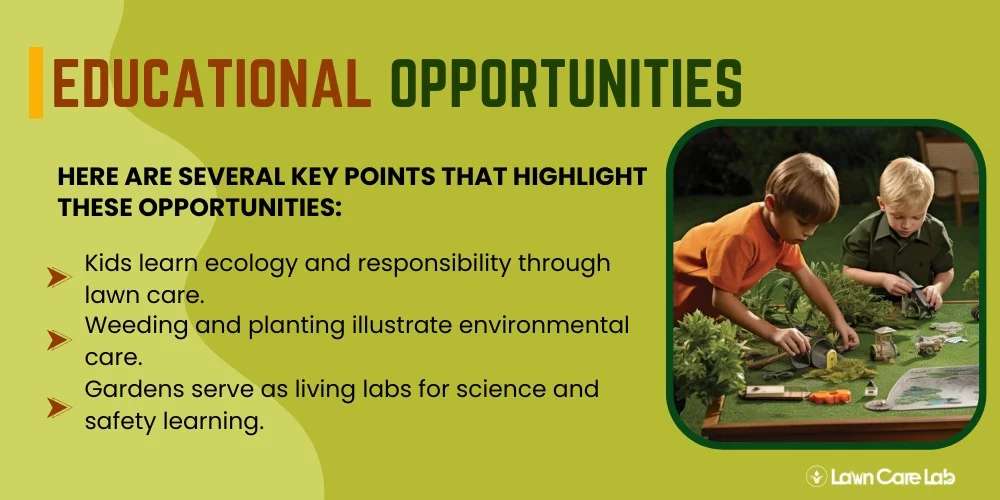
Involving kids in lawn care teaches them to respect nature and appreciate biology. It’s a tangible way to instill environmental stewardship and curiosity about the world.
Plus, a well-maintained garden provides a visual reward for their hard work and encourages continued involvement.
Teaching Environmental Responsibility Through Weeding and Planting
Teach your children environmental stewardship through fun outdoor activities like weeding and planting in your own backyard.
Here’s how you can kickstart this process in four straightforward steps:
- Clarify the reason for weeding: Point out that weeds pose a threat to plants, as they vie for the same vital resources such as nutrients, water, and sunlight.
- Demonstrate the proper way to weed: Teach your children the right technique by grabbing the weed from its base and gently pulling it out.
- Assist them in planting: Guide them as they dig a hole, position the plant, and then cover it with soil.
- Highlight the need for regular upkeep: Discuss the requirements of watering, exposure to sunlight, and the use of pest control methods.
Kids learn about lawn upkeep and plant growth, gaining knowledge and responsibility. Turning your backyard into a classroom is a small but significant step in instilling this perspective in the younger generation.
The Science Behind Lawn Maintenance and Plant Growth
The science behind lawn maintenance and plant growth provides a practical way for children to learn about ecology.
They can observe photosynthesis in action, where plants use sunlight and nutrients to grow, and see the roles of pollinators in the garden ecosystem. These real-world lessons underscore the interconnectedness of life and the importance of environmental care.
While engaging with this living laboratory, practicing safety, like wearing gloves and supervising tool use, is crucial to protect young gardeners as they explore and learn.
Safety Measures for Engaging Kids in Lawn Care
When inviting your children to participate in yard maintenance, prioritize their safety. Equip them with appropriate protective gear and educate them on using gardening tools properly.
Teach them about the potential risks associated with certain plants and garden critters. As families turn to home gardening as a learning experience, ensuring safety remains paramount.
Proper Protective Gear and Safe Gardening Practices for Kids
Before your children embark on their green-thumbed journey, outfitting them with suitable protective attire and imparting knowledge of secure gardening methods is paramount.
Gloves: These are essential to safeguard their tender hands from prickly thorns, soiling, and possible allergens.
Hats: A necessary shield against the potentially harmful ultraviolet rays, which can lead to sunburns and lasting skin damage.
Sturdy Footwear: A pair of robust shoes can defend against any sharp objects concealed in the grass, ensuring their feet remain unharmed.
Gardening Practices: Educate them about the respect that nature commands — never uproot a plant by its stem, and always handle gardening tools with care and caution.
Securing safety is a top priority. These precautionary measures preserve your child’s safety and foster a sense of responsibility toward gardening.
Identifying Hazardous Plants and Garden Pests
Teaching kids to identify hazardous plants and garden pests is essential for a safe gardening experience.
Use pictures to help them recognize plants like poison ivy and bugs that could sting or bite. Turn any encounters with these dangers into teachable moments, emphasizing avoidance and care.
It’s about fostering awareness and smart gardening habits to keep the whole family safe while working in the garden.
Celebrating Lawn Care Achievements as a Family
Celebrating your family’s lawn care achievements cultivates a sense of pride and encourages a deeper connection with gardening among children.
Recognize their individual contributions with enthusiasm—applaud their perseverance in tasks like weeding or planting. Curiosity about their efforts shows genuine interest and encourages further exploration. Celebrate each milestone, like the bloom of a new flower, with shared excitement and perhaps a fun title, like ‘Garden Champion,’ to recognize their developing skills.
Above all, prioritize safety and ensure they’re equipped with the right tools. Engaging them in rewarding projects, such as growing their own vegetables or building a birdhouse, teaches invaluable life lessons and nurtures a sense of accomplishment.
Always supervise these tasks to ensure their safety and take the opportunity to strengthen your family’s bond through these shared victories in the garden.
Conclusion
Involving your children in lawn care goes beyond the task of yard maintenance. It becomes a unique opportunity to engage in meaningful interactions, impart life-long lessons, prioritize safety, and enjoy the process.
Celebrating your collective efforts is a rewarding experience, transforming an ordinary yard into an oasis of lush greenery. But it’s more than just about nurturing the landscape; it’s about instilling an appreciation for nature and fostering responsibility in your young ones.
So, here’s to joyous gardening and creating lasting memories!
- How to Create a Lawn Care Schedule for Southern Climates - October 30, 2024
- How to Use Compost Tea to Boost Lawn Growth and Soil Health - October 23, 2024
- The Best Grasses for Saltwater-Exposed Lawns: Coastal Lawn Care - October 17, 2024


